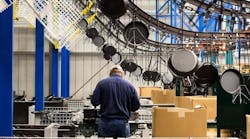Citizens Want ‘Made in America.’ Washington Needs to Make It a Reality.
As the tragic toll of the COVID-19 pandemic continues to rise, the United States is facing ongoing shortages of medical supplies and generic drugs. It’s now clear that the U.S. relies heavily on countries like China for a broad range of everyday goods—including everything from antibiotics and medications to computers and electronics. This dependence is particularly troubling in light of Beijing’s aggressive strategy to dominate global manufacturing. And Americans are wary of China’s motives, especially after Beijing’s deceitful behavior at the onset of the coronavirus pandemic.
There’s a clear message for the United States—it’s strategically unwise to keep relying on a global competitor actively working to erode America’s prosperity and global leadership.
Americans are now saying this loud and clear. A recent poll shows that 66% of the American people hold a negative view of China, and 91% say the U.S. should continue to be the world’s leader. This trend is borne out in their shopping, with consumers buying American-made products like never before.
Margarita Mendoza, founder of the online marketplace madeinamerica.co, says that her website saw an 825% increase” in consumer interest between March 26 and April 22. Mendoza adds that this uptick is rising steadily. And Don Buckner Sr., who runs the site MadeInAmerica.com, reports that inquiries for American-Made products have gone up 2,000% in recent weeks.
This is hopeful news for America’s manufacturing workers, since the United States has lost roughly 5 million good-paying manufacturing jobs over the past 20 years.
Greg Owens is the CEO of Liberty Tabletop, in Sherrill, New York, the only flatware manufacturer in the United States. He says that Liberty has seen a surge in business recently, with orders up 50% at the start of April compared to 2019. By the middle of April, Owens found that his company’s web sales had doubled from 2019 levels.
When asked about the increased sales, Owens said, “We certainly wish it was under better circumstances. But for good reasons, the made in America brand has become gold. In contrast, the made in China brand is now toxic.”
Owens’ rising sales are mirrored in data from Google Trends. The term "Made in USA" is currently tracking at an all-time high since 2004.
Zach Mottl of Atlas Tool Works in Lyons, Illinois, tells a similar story. His company provides metal fabrication and machining for a variety of industries, including medical, defense, and aerospace as well as telecom and consumer products. His company’s recent sales are up roughly one-and-a-half times their usual volume. Mottl attributes this partly to a growing recognition that U.S. manufacturers “follow higher quality and safety standards than competitors in China.” And he believes that U.S. manufacturers have repeatedly proven to be “more reliable and easier to deal with.” This matters in particular for fast-moving and highly-complex products that “must be done right the first time.”
When asked about the current crisis, Mottl adds, “The COVID pandemic has been tragic for many reasons. But if we can find a way to move forward, it’s to stop being so reliant on a country like China that doesn’t have our best interests at heart.”
Bryan Hurley, the owner of Florida-based Americraft Cookware, says that his sales have been up 167% of late compared to 2019. His customers keep saying, “We don't want anything made in China.” Hurley has even received calls from companies looking to reshore production from China—with owners telling him that his current 2020 prices aren't much different from the prices they were paying last year for similar products made in China.
Right now, U.S. manufacturers are increasing production of COVID supplies and retooling to respond to the pandemic. They are doing what is necessary to make the nation prosperous and self-reliant. However, Congress needs to make a similar shift—and finally start getting trade policy right to make this trend permanent.
President Trump needs to issue an executive order requiring the government to buy American-made goods. This will allow manufacturers to invest long-term to provide needed supplies—without worrying that more of their business will move to China.
The Federal Emergency Management Agency (FEMA) must stop focusing on lowest-price suppliers for COVID relief because that merely supports subsidized competition in China.
More broadly, the U.S. needs a new “Made in America 2030” strategy that focuses on self-reliance in critical industries like artificial intelligence and pharmaceutical production. This may require tariffs and quotas, to prevent aggressive trade cheating from countries that flooding our market with cheap goods. But we need to protect part of our home market for domestic producers. That’s what China is already doing with its Made in China 2025 program.
Arguably the largest impediment for America’s manufacturing competitiveness is that the U.S. dollar remains heavily overvalued. The dollar’s continued rise is due largely to the ongoing demands of private foreign investment in America’s financial markets. An uncompetitive dollar reduces import prices while making U.S. exports more expensive.
Congress should immediately pass currency legislation introduced in the Senate last year to make the dollar more competitive. That would provide a huge boost for America’s manufacturers as they struggle against heavily subsidized factories in China.
There’s little time to waste. America must bring back key industries from China to create millions of good-paying jobs, jumpstart the economy, and make the nation stronger than before the COVID pandemic. The encouraging part is that America’s consumers want to see a resurgence of “Made in America.” Now, Washington needs to make it a reality.
Michael Stumo is CEO of the Coalition for a Prosperous America (CPA). Follow him at @michael_stumo.Main photo: Interior of a Lodge manufacturing facility in South Pittsburg, Tennessee.




